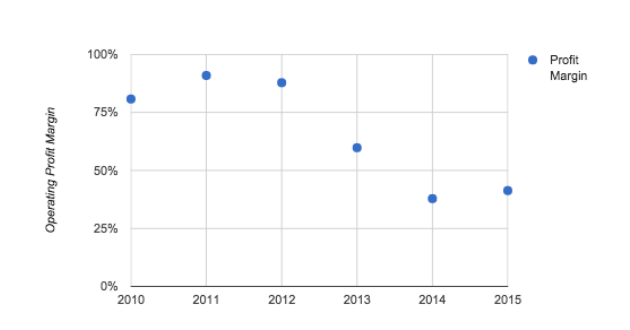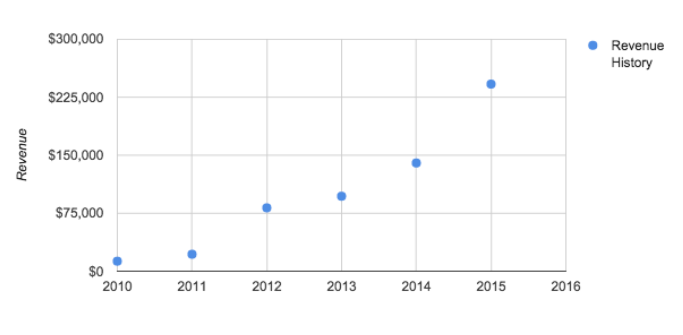One of the planning questions I am often asked is how to plan revenue and forecast financials for the year ahead.
How do you know how many people will actually buy what you are offering?
How do you forecast when you are just starting out?
How do you forecast and create a realistic revenue plan?
Big and small companies struggle with this process. I’ve seen it all – Forecasts come true, forecasts surpassed, and forecasts gone very, very bad. You’ll be better at this process and you’ll be able to better predict your revenue and income for the year ahead if you consider a few key things as your business grows.
Since I am working on this right now, I figured I’ve give you a little behind the scenes to walk you through how I do this in one of my businesses so you can modify and apply it to yours as well.
The key to forecasting?
Metrics.
Here’s your invitation to see the nitty-gritty in the photography business I founded and run in collaboration with my business partner. Note that this is not your typically online marketing business. We meet with people in person but use a lot of online marketing principles to grow our business. I’ll call out differences and opportunities for you to apply what I am doing here to your business, regardless of what you do.
Before we dig in, let me give you a little background on this company we’ve been building since 2009.
Business Overview
Boudoir photography for women
Founded in 2009 as a side hustle
Added first team member in Fall 2012
List Size – Small, Very Small
Historically, our photography business has leveraged online marketing best practices including SEO and Facebook Advertising; however, we have grown the business leveraging without a list of our own. Currently, the photography business has 1600 people on in its CRM database. The vast majority of these contacts are existing or prior clients already – not prospects. We’ve shot thousands of boudoir photo shoots since 2009 when we started up. Our primary marketing source has been through deal sites like Livingsocial and Groupon.
Planning Question for you —> What are your list/growth goals for this year?
Marketing Focus – Leveraged
Why partner with deal sites like Livingsocial or Groupon?
We wanted reach quickly to test and make our business model viable. Deal sites offered us an opportunity to reach a large audience with little marketing ramp up time of our own. Could we have grown with organic reach and paid advertising – absolutely. However, it would have been a slower growth strategy due to the time we had to invest as side-hustlers and the money we had to invest.
Much like affiliate marketing in the online world, we had a 50/50 revenue split with the deal sites when we first started our partnerships. In the first 1.5 years of running our business we developed a strong system so we could managed increased volume when the time came. We knew we’d have to have a solid approach for generating revenue and sales after the deal ran and was purchased so we didn’t end up like this unlucky cupcake company.
While we’ve had a leveraged model in the past by partnering with deal sites and we will continue this in 2016, we have an opportunity to further leverage funnels and paid advertising to turn prospects into clients in addition to the clients that come to us through the deal site. As we mature, it is a weakness to rely almost exclusively on deal sites for our leads and it puts us at risk if the deal sites business unfavorably impacts ours.
Planning Question for you —> Do you have a marketing strategy that is aligned to where you are in business today?
Pricing Strategy – Premium
Our photography business offers an experience for women including a team of photographers and coaches who have been trained by a former playboy model. Many of our clients are a little nervous when they first come to shoot with us – It’s our goal and our mission to create an amazing photography experience for our clients. We know they will love their photos – We women are more gorgeous that we know. Due to the incredible experience, after about 10 minutes of shooting, we move past the nerves and move into the fun!! Women walk out with newfound confidence and we know that’s worth more than the actual photos! But, the photos are what we deliver. And they are incredible too! We have amazing equipment, our products are high-end, and we spend a considerable amount of time designing products for our clients to deliver as gifts to their loved ones or keep as a memory of how smokin’ hot they are.
With all of this in mind – a shoot coach and a photography in the shoot, high end products, an incredibly uplifting experience, we have positioned ourselves as a premium boudoir photography company.
Checkout out our 2010 pricing guide here.
Due to the deals we run, there is a low barrier to entry when it comes to working with us. However, our products are high quality and the prices are aligned to that.
Planning Question for you —> What’s your pricing strategy?
Team Make Up – Strong
2009
We had our first paying client that was not friends and family. 🙂
2009 – 2011
My partner and I tag teamed everything. Without her incredible partnership, this whole business thing NEVER would have happen. Our skills complement each other amazing well. I like numbers. She’s a wiz at making it happen. I’m impatient. She reminds me that it will all happen exactly when it is supposed to. We are both also incredibly focused on having killer systems and processes in place. We practice what we preach ala How to Clone Yourself. Again, this was a side-hustle for both of us so we needed strong systems to manage everything and get our full time jobs done. We shoot primarily on the weekends and we’d do everything else in the evening.
My partner managed pre-shoot set up — She rocks at timely follow up, which matters in sales. In addition, she could speak to everyone’s shoot fears leveraging her experience as a former playboy model.
I managed all post-shoot communications and emails, editing, product design, and delivery. The experience continued in all post-shoot communications.
2012
We added our first team member in the fall of 2012. An Experience Manager came onboard to help us manage design and order fulfillment after shoots. It was getting to be too much for just the two of us. My partner wasn’t ready out outsource just yet, but I needed to harness the power of Cloning so I didn’t lose my mind and could stay focused on the prize. I paid for my sister out of my half of the profit distribution payments.
Eventually, the Experience Manager also took on project management of all orders. I continued to manage financials, shoot photos with my business partner as coach in the shoots, and strategy.
Late 2013
The Experience Manager transitioned off of the team as she moved onto new projects and we added another resource to do project management, design, and all post-shoot activities. I continued to manage financials and complete shoots. We did add a second photographer at this time and tested another shoot coach as well. We discovered that our new team members were equally as wonderful at creating the experience we wanted to maintain for our clients, and they were better than us at the sales process.
We also added Infusionsoft in the summer of 2013 to automate our client onboarding and post-shoot engagement. My business partner managed all Infusionsoft setup.
2014
We added two photographers – One for our Maryland location and one for our new DC location. The Experience Manager began coaching through shoots after a fall of training from the former playboy model. I stopped shooting entirely. My business partner continued to coach in DC shoots with the DC photographer.
The additional team members are not full time. They are contractors who receive a commission for shoot time based on associated sales and an hourly rate for time spent editing and shoot follow up.
2015
My business partner spent less time in shoots and most shoots were managed by our team members. The team really takes a leadership role in all parts of running the business. It’s incredible to see them in action and I feel crazy grateful for them.
2016
We are actively evaluating our 2016 revenue goals and determining how many shoots and, subsequently, if we will need an additional photographer-coach team or even a second location to meet our revenue goals. To determine if additional team members are needed or not, we are looking at all of our historical metrics, and forecasting for the future.
We are not currently looking seriously at alternative or more passive revenue streams (digital products, etc), although we toss ideas around regularly and tested an idea in 2011 called Self-Love Lift that might make a comeback someday.
Planning Question for you —> Do you have any team needs in 2016? It’s okay to start small and dip a toe in. The key is to add A-players to your team!
Metrics
This is where the forecasting magic happens!! If you don’t have an eye on key metrics in your business, this process will be incredibly difficult and it will feel like you are going in blind.
Frankly, this is a process that big and small organizations are challenged with. You can make it easier on yourself if you know your business’ numbers.
For example, we know that 1198 people bought a deal via our partners in 2015.
From deals purchased, 52% (or approximately 600 people) of people actually schedule a shoot.
We also know that 64% of people who book actually make a purchase following their shoot.
The average purchase price was $504 in 2015, which is up approximately $50 over 2014 and $100 over 2013.
With this information, we plug in some numbers to determine what will happen in our business if we can get more leads or more deals sold. Here’s a breakdown of how many shoots we would need to have to reach various revenue targets in 2016:
 Revenue estimates above are for products only and do not include other revenue received from partners via deals purchased, revenue associated with makeup application purchases, and numbers are for illustrative purposes only and are rounded for ease of reference. In addition, 2015 numbers are not yet final.
Revenue estimates above are for products only and do not include other revenue received from partners via deals purchased, revenue associated with makeup application purchases, and numbers are for illustrative purposes only and are rounded for ease of reference. In addition, 2015 numbers are not yet final.
With growth, there are also system needs and team member and staffing needs that will arise. Simply put, more volume equals the the need for more efficient systems and more time for existing team members or new team members if the current team members are at capacity.
Planning Question for you —> What key metrics do you need to look at to complete your revenue forecast?
Consider places in your client experience that people have the opportunity to meet you and buy from you. At each of those checkpoints, there is an average of people who actually purchase after marketing is complete.
For example, if Facebook ads are primary marketing source for you, how many people will click your ads? How many that click actually sign up? How many that sign up for the list/offer you drove them to actually buy? Tracking these numbers will help you forecast your revenue better and better every year.
Revenue
We’ve steadily increased our revenue year over year while adding team members so we didn’t have to assume all of the work as the business grew.
Revenue chart is for illustrative purposes only. 2015 numbers are not yet final and are a year end estimate.
Profit Margins
Profit Margins were higher when my business partner and I did all of the work during evenings and weekends. Margins decreased as we added team members, but we were able to increase revenue as well. As we go into 2016, we’ll be looking for opportunities to grow both revenue and profit. To this day neither my business partner or I are full time in this business.
 Profit chart is for illustrative purposes only and are rounded for ease of reference. Profit from 2010 – 2013 does not include individual expenses partners had for the business that were not reimbursed by the company. 2015 numbers are not yet final and are a year end estimate.
Profit chart is for illustrative purposes only and are rounded for ease of reference. Profit from 2010 – 2013 does not include individual expenses partners had for the business that were not reimbursed by the company. 2015 numbers are not yet final and are a year end estimate.
What key metrics do you need to look at to complete your revenue forecast?
Consider places in your client experience that people have the opportunity to meet you and buy from you. At each of those checkpoints, there is an average of people who actually purchase after marketing is complete.
What’s Next for You?
Create your revenue plan of course!!!
Where do you start?
Be sure to hit us up in the comments with your ah-has and questions. You can also join us here in our very Nice Facebook group where we are covering all things planning.
Can’t wait to hear what metrics you will be tracking to create your revenue forecast to rock out this year!
Amber




